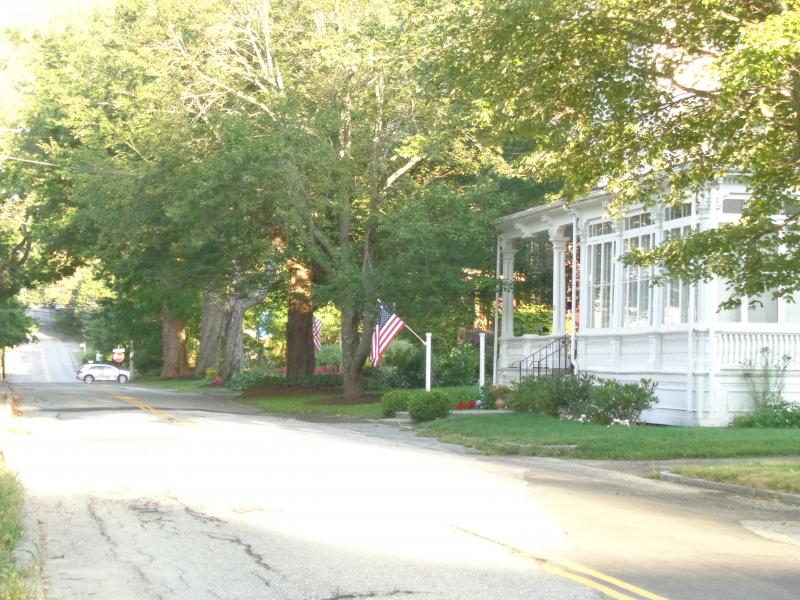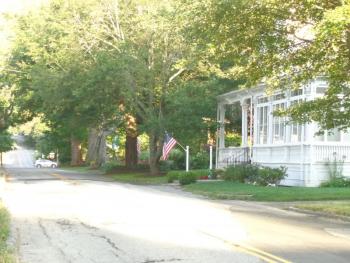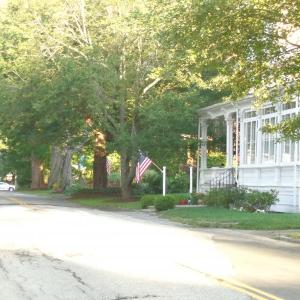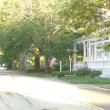Rockland walking tours dig up arcane facts about a storied small city
 Cobble stone once adorned this street. When one of the Talbots bought one of the first cars in Rockland, he protested the city for the paved road. The street was then renamed Talbot. (Photo by Sarah Thompson)
Cobble stone once adorned this street. When one of the Talbots bought one of the first cars in Rockland, he protested the city for the paved road. The street was then renamed Talbot. (Photo by Sarah Thompson)
 Cobble stone once adorned this street. When one of the Talbots bought one of the first cars in Rockland, he protested the city for the paved road. The street was then renamed Talbot. (Photo by Sarah Thompson)
Cobble stone once adorned this street. When one of the Talbots bought one of the first cars in Rockland, he protested the city for the paved road. The street was then renamed Talbot. (Photo by Sarah Thompson)
ROCKLAND — Interest is still growing in Rockland Historical Society’s history-based walking tours of the neighborhood behind the library and a variety of similar tours are being considered for other parts of the city.
Tours are lead by Rockland Historical Society member Alice Keen, and the content is rich with examples of American life as evidenced through the microcosm of Rockland buildings built between 1835 and 1945. The buildings encompass a zone of a city, which, around 1900, boasted the fourth busiest harbor in the country.
Keen has started planning self-directed tours of Rockland, and other Society members have listed possible harbor walks and tours of the North End, South End, and Main Street as possible accompaniments to this walk.
She is also considering eliminating the reservation requirement in favor of participants simply arriving at the scheduled time.
Keen, who majored in history, has only lived in Rockland for few years. In that time, the influence of 90-year-old resident Society member Betty Knight triggered Keen’s involvement with the Society and her offer to guide this new fundraising venture.
A former resident of Boston, she led walking tours in that city for an organization that required guides to attend six days of training. Her previous experience helped her to prepare an organized summary of each structure on her Rockland route. Yet she could not predict, before her initial tour, what to share of the endless facts she’d accumulated.
As she goes through each new tour, she’s learned to trim the facts, and ask the listeners for their interests. For people in the groups, which have consisted of a mixture of locals, summer residents, and one person staying at a local inn (facts about the Berry Manor Inn and the Limerock Inn are mentioned), general information, along with a sense of the fishing and shipping industries, have been requested.
In the most recent tour, a married couple found the architecture most interesting.
Rockland is home to 70 double houses, according to Keen. The structures, native to New England and coastal communities, allow for the living space on one side to be identical to that of the other side. The idea was to house another branch of the family on the same property — a useful condition when the father of one household goes to sea for a year or two.
And, of course, family ties come in to play. Many a time, as Keen has stopped to present the history of a house, a tour attendee has proudly announced the name of the relative who once occupied that space... and the one next door... and the one across the street.
As Keen sat in the Historical Society room a few days after her most recent tour, she mentioned those family ties.
“Somebody just left who is related to just about all the families on the map of the tour area,” she said. “His roots go way, way back. He did not grow up here, but he inherited a great aunt’s home. He’s an Ingraham. He’s a Keene. I think he is related to just about everyone. He has real roots here.”
For Keen, these facts are welcomed additions to her own education of the area.
The library may be the first public lender of books in the area, but it was not the first; Small, private book collections existed all around. One of which was in the Thomaston prison in 1830.
The education buff may find interest regarding early teachers of Rockland High School. Before 1873, teachers in Rockland's primary schools weren't required to be educated beyond high school. That year, attendance at a Normal school was added to the requirements, but if an applicant was unable to do so, one or two terms of observation of primary classes would suffice.
Knott Crockett’s father died when Knott was 15, leaving behind Knott, five more children, Knott’s mother, a large property, and a very large mortgage.
Knott began burning lime (take the tour and find out where the term “in the lime light came from”) in one small kiln.
Eventually, he added farmer and school teacher to the job sources he used to support his mother and siblings. Within 10 years, he’d paid off the mortgage and bought a small store. From there, he became a successful merchant, one of the first directors of the first marine insurance company in this area, the first president of Rockland's first bank and the first mayor of Rockland.
Much more Rockland history is presented during Keen’s tours, with the $10 admission fee contributing to general operating costs of the Historical Society.
For reservations, contact the Rockland Historical Society, located on the lower level of the Rockland Public Library, open Tuesdays and Thursdays, from noon to 5 p.m.
The phone number is: 207-594- 6193. Brochures are available at the Historical Society, the Library, and the Chamber of Commerce.
The final two walking tours of autumn will be Saturdays, Sept. 24 and October 15 at 10 a.m. Originally, an October 1 date was also scheduled. That has been cancelled since Keen will be out of the country.
The Historical Society’s annual post card show also takes place Saturday, Sept. 24, 2016, from 10 a.m. to 3 p.m. at the Congregational Church on Limerock Street.
Sarah Thompson can be reached at news@penbaypilot.com.
Event Date
Address
United States



























